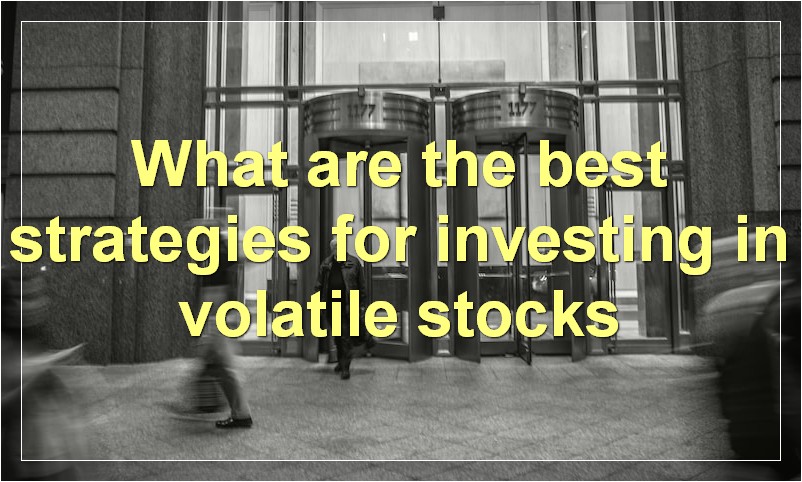In the stock market, there are always opportunities to make a profit. Even in the most volatile markets, there are ways to profit from stocks. Here are some tips on how to profit from volatile stocks.
What are volatile stocks
Volatile stocks are those that can experience large swings in price over a short period of time. They can be either good or bad investments depending on your investment strategy. For investors who are looking for quick gains, volatile stocks may be a good choice. However, they can also be risky and could lead to losses if the market moves against you. It is important to do your research and understand the risks before investing in volatile stocks.
What factors make stocks volatile

Volatility is a measure of how much the price of a security, commodity, or index fluctuates. It is calculated using standard deviation and is often used to measure risk.
There are a number of factors that can make stocks volatile, including:
1. Economic conditions: Changes in economic conditions can have a big impact on stock prices. For example, if there is news of an economic recession, this can cause stock prices to fall sharply as investors become worried about the future.
2. Company-specific news: News about a company, such as earnings results or a change in management, can also impact its stock price. Positive news may lead to a rise in the price, while negative news can cause it to fall.
3. Market psychology: Investor sentiment can also play a role in how volatile stocks are. If there is a lot of fear or optimism in the market, this can lead to large swings in stock prices.
4. Geopolitical events: Major geopolitical events, such as wars or natural disasters, can also impact stock prices. These events can cause uncertainty and lead to investors selling off their holdings.
5. Technical factors: Finally, technical factors can also influence how volatile stocks are. This includes things like the level of trading activity in the market and changes in the overall level of market volatility.
Why do some investors prefer volatile stocks
There are a few reasons why some investors prefer volatile stocks. Firstly, volatile stocks tend to have higher returns than non-volatile stocks. This is because investors are willing to pay more for a stock that has the potential to go up or down sharply, in hopes of making a quick profit. Secondly, volatile stocks are more exciting to trade, and can provide more opportunities for profit. Finally, volatile stocks tend to be more heavily traded than non-volatile stocks, so there is more liquidity and it is easier to buy and sell them.
How can investors profit from volatile stocks
Volatility can be a good thing for investors if they know how to profit from it. When a stock is volatile, it means that the price is moving up and down a lot. This can be a good thing for investors because they can buy when the price is low and sell when the price is high.
If you are thinking about investing in volatile stocks, there are a few things you should keep in mind. First, you need to be comfortable with risk. Volatile stocks are more risky than stocks that don’t fluctuate in price as much. Second, you need to have a plan. You should know when you want to buy and sell the stock. Lastly, you need to be patient. Don’t expect to make a lot of money overnight with volatile stocks. If you are patient and follow your plan, you can make a lot of money from volatile stocks.
What are the risks of investing in volatile stocks
Volatile stocks are those that fluctuate dramatically in price, often without any clear reason. They can be incredibly risky investments, as they are often subject to sudden and unexplained changes in price. This can make it difficult to predict when they will rise or fall, and can lead to substantial losses. For these reasons, volatile stocks are often best avoided by investors who are risk-averse.
What are the best strategies for investing in volatile stocks

Volatile stocks are those that experience large swings in price over a short period of time. They can be risky investments, but they can also offer the potential for big rewards. If you’re thinking of investing in volatile stocks, here are some strategies to help you make the most of your investment.
1. Have a reason for buying.
Before you invest in any stock, it’s important to have a good reason for doing so. With volatile stocks, this is even more important. You need to have a clear idea of why you’re buying the stock and what you expect it to do. Otherwise, you could end up making an emotional decision that you later regret.
2. Set a stop-loss order.
A stop-loss order is an order to sell a security when it reaches a certain price. This can help limit your losses if the stock price falls sharply. For example, let’s say you buy a stock for $10 per share. If you set a stop-loss order at $8, then the stock will be sold automatically if it falls to that price. This can help you avoid losing too much money on a single investment.
3. Consider using leverage.
Leverage is the use of borrowed money to increase your potential return on investment. When you use leverage, you’re essentially betting that the stock price will go up. For example, let’s say you buy $10,000 worth of stock with leverage at 2:1. This means you’re borrowing $20,000 from your broker to buy the stock. If the stock price goes up 10%, then your investment will be worth $22,000 (10% x $20,000). However, if the stock price falls 10%, then your investment will be worth $18,000 (10% x $20,000). As you can see, leverage can magnify both your gains and your losses. Therefore, it’s important to use it carefully.
4. Diversify your portfolio.
When you invest in volatile stocks, it’s important to diversify your portfolio. This means investing in different types of stocks and other assets as well. That way, if one investment loses value, your overall portfolio won’t take as big of a hit. For example, let’s say you have a portfolio that’s invested 50% in stocks and 50% in bonds. If the stock market falls by 10%, then your portfolio will lose 5% of its value (10% x 50%). But if the bond market rises by 5%, then your portfolio will actually gain 2.5% in value ((5% x 50%) – (10% x 50%)). So even though one part of your portfolio lost value, the other part gained value, offsetting some of the loss. Diversification can help reduce the overall risk of your investments and improve your chances of achieving long-term success.
5. Stay disciplined with your investing strategy.
When investing in volatile stocks, it’s important to stay disciplined with your strategy. This means sticking to your plan even when things are going bad. It can be tempting to Sell when the stock price falls or to Buy when it rises sharply. However, these decisions are often made based on emotion rather than logic. If you want to be successful with volatile stocks, you need to stick to your plan and make decisions based on sound analysis.
Volatile stocks can be risky investments, but they can also offer the potential for big rewards. If you’re thinking of investing in volatile stocks, these strategies can help you make the most of your investment and improve your chances of success.
What are the most volatile stocks on the market today
There are a few stocks that tend to be more volatile than others on the market today. These include:
1. Biotech and pharmaceutical companies: These stocks can be very volatile because they often rely on a small number of products that can be susceptible to clinical trial failures or regulatory hurdles.
2. Small-cap stocks: Small-cap stocks tend to be more volatile because they are less liquid and have less analyst coverage than large-cap stocks.
3. Stocks with high short interest: Stocks with high short interest tend to be more volatile because there is a larger group of investors betting against the stock.
4. Turnaround stocks: Stocks that are in the midst of a turnaround can be very volatile as investors wait to see if the company will be successful in its turnaround efforts.
5. Commodity stocks: Commodity stocks can be volatile because they are often reliant on the price of commodities, which can be very volatile.
What is the difference between volatile and non-volatile stocks
Volatile stocks are those that tend to see big swings in price, often in a short period of time. They can be more risky to invest in, but also offer the potential for greater rewards. Non-volatile stocks, on the other hand, are typically more stable in price and offer less upside potential.
What are some tips for investing in volatile stocks
Volatile stocks are those that tend to fluctuate rapidly in price. They can be riskier investments, but can also offer greater rewards. Here are some tips for investing in volatile stocks:
-Do your research. Be sure to understand the risks involved before investing in any stock, but especially volatile ones.
-Start small. Don’t put all your eggs in one basket, especially with volatile stocks.
-Have a plan. Know what you’re trying to achieve with your investment and stick to it.
-Be prepared for bumps in the road. Volatile stocks will inevitably have ups and downs, so don’t panic when prices drop.
-Monitor your investments. Keep an eye on your stocks and sell if they fall below a certain price.
What are the benefits and drawbacks of investing in volatile stocks
Volatile stocks are stocks that experience large swings in price over a short period of time. They can be risky investments, but they can also offer the potential for large rewards.
The main benefit of investing in volatile stocks is the potential for high returns. If you buy a stock when it is low and sell it when it is high, you can make a lot of money. However, this is also the biggest drawback of volatile stocks. If you don’t timed your investment properly, you could end up losing money.
Another benefit of volatile stocks is that they can help you diversify your portfolio. By including some volatile stocks, you can offset the risk of investing in other, more stable stocks. This can help protect your portfolio from losses in the event that one particular stock or sector experiences a downturn.
The main drawbacks of volatile stocks are the risks involved and the fact that they can be difficult to time correctly. However, they also offer the potential for high rewards. If you are willing to take on the risks, investing in volatile stocks could be a good way to boost your returns.

